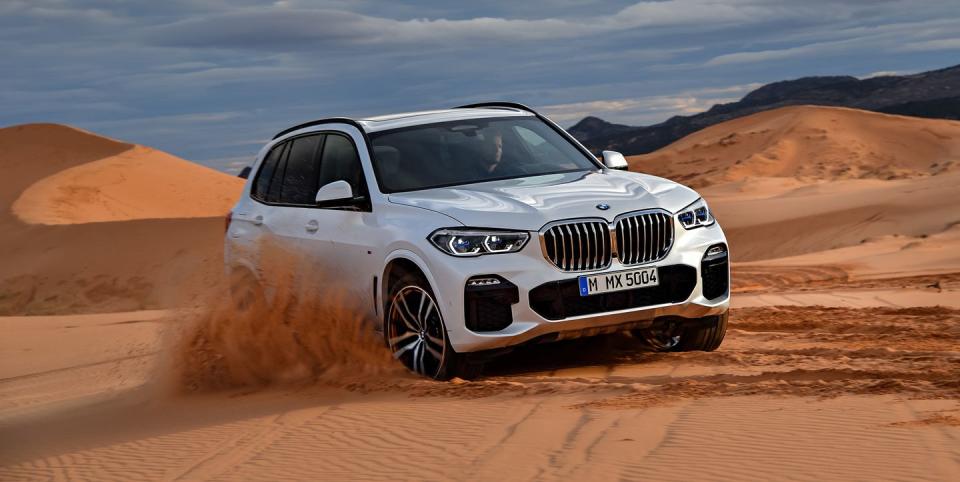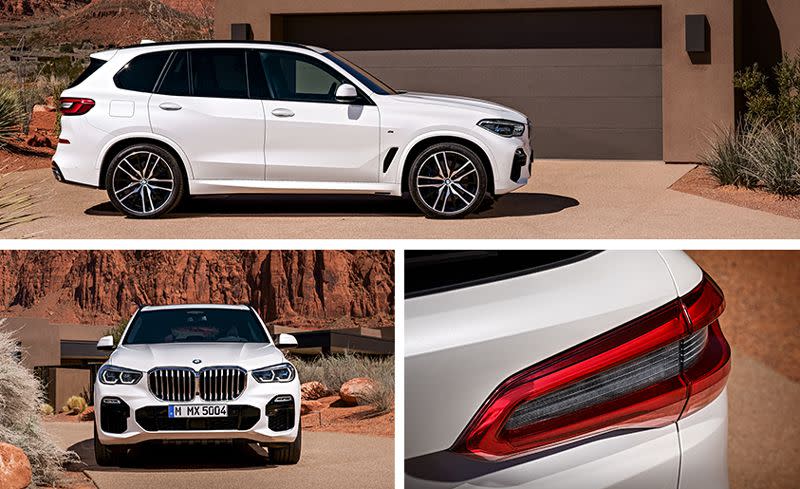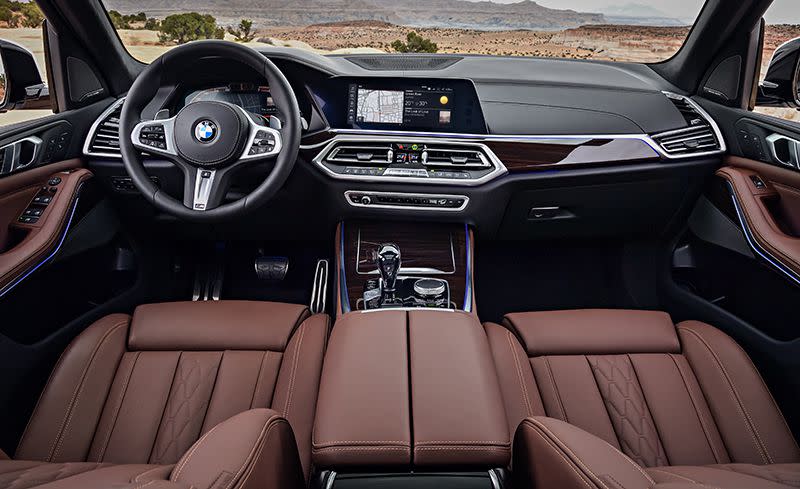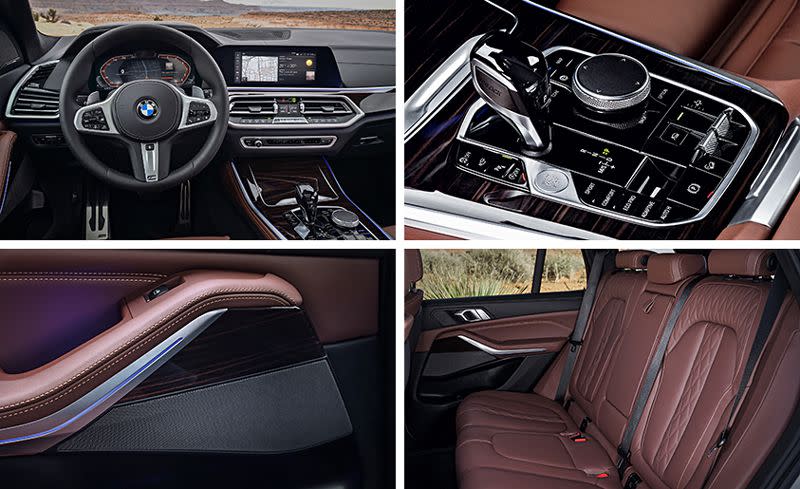2019 BMW X5: Back to Bimmer Basics?

When it debuted for 1999, the stalwart BMW X5 was the first sporty SUV. The model has remained popular, but it has also become a poster child for the loss of athleticism that has spread throughout the BMW brand in recent years. In our last comparison test, a 2015 model X5 placed last, behind an Audi Q7, a Volvo XC90, and a Range Rover Sport. The X5 was dragged down by its dull driving demeanor, tight third row, and ho-hum design, despite offering a stirring straight-six, expansive outward visibility, and relatively modest mass. The 2019 model now making its debut should maintain those strengths while addressing the outgoing model’s shortcomings.
Six and Eight
The turbocharged inline-six and V-8 engines return. Badge inflation sees the model designation for the six go from 35i to 40i, as it has across the BMW lineup, even though displacement remains at 3.0 liters. Output grows from 300 to 335 horsepower, with torque increasing from 300 to 330 lb-ft. The 4.4-liter V-8 engine in the 50i now makes 456 horsepower (versus 445) and the same 479 lb-ft as before. A diesel model will again be offered, although not until the 2020 model year at the earliest, at which point a plug-in hybrid also will rejoin the lineup. Both engines pair with an eight-speed automatic transmission that gets a wider ratio spread and sends torque to all four wheels. A rear-wheel-drive version may return for 2020.
The exterior dimensions grow slightly larger, but the overall appearance is little changed-BMW no doubt was loath to stray too far from what has been a winning formula. The body is 1.1 inches longer and 1.0 inch taller, while width has grown by 2.6 inches, and the vehicle rides on a 1.6-inch-longer wheelbase. The grille is now deeper and canted slightly forward, with active shutters to aid aerodynamics. It’s flanked by LED headlights, with BMW’s laser lights available as an option. The main body-side crease now hops up over the rear wheels. The taillights have a more three-dimensional appearance than before and are illuminated via LEDs. An available M Sport appearance package brings a restyled front fascia, more-sculpted rocker panels, and body-color and gloss-black trim, along with 20-inch wheels in place of the standard 19s-although buyers can opt up to 21s or 22s.
Underneath, the chassis employs standard adaptive dampers and steel springs, with firmer M Sport tuning optional. The next level up is air springs at all four corners-versus the current model’s rear-only setup-to which one can add active anti-roll bars. An available off-road package requires the air springs and includes an electronically controlled limited-slip rear differential along with underbody skid plates. Integral Active Steering (rear-wheel steering) is a stand-alone option.
Bring the Bling
The new model’s interior makes the outgoing car look like the oldie that it is, with a new 12.3-inch infotainment touchscreen that boasts an up-to-the-minute graphic presentation, along with a similarly sized digital instrument cluster as standard. Gesture control comes to the X5 as an option alongside the standard iDrive clickwheel. A sunroof is standard, with a panoramic unit optional. That the gear lever, iDrive controller, volume knob, and stop/start button can be optioned in glass affords further opportunity to up the glitz factor. The standard ambient lighting takes a cue from nightclubs, with BMW boasting that it “emits pulsating light signals” in response to various stimuli, including a door opening or an incoming phone call. Sounds fun.
We’ve seen the vehicle in person, and the front seats are roomy, as is the three-person second row, which can be fitted with power-folding capability. A third-row seat is optional and will be available shortly after launch, although space in the third-row seat doesn’t materially improve. BMW must expect that the new, larger X7 coming later this year will cater to that crowd. The cargo hold does gain a few new tricks, however. The handy two-piece liftgate is retained, but both the upper and lower elements are now power operated, with available hands-free operation. A button at the edge of the drop-down portion can lower the vehicle’s suspension (if equipped with air springs) by 1.6 inches to facilitate loading. Other buttons power-fold the second- and third-row seatbacks on models fitted with the third row. The optional power cargo cover disappears into the floor when not in use-a particularly neat trick.
Standard driver-assist and active-safety features include blind-spot warning, lane-departure warning, forward-collision warning with pedestrian and cyclist detection, automated emergency braking, rear cross-traffic alert, rear-collision warning, and speed-limit recognition. Automated parking is available, and a more capable Driving Assistant Professional package includes upgraded adaptive cruise control that allows for automatic lane-change capability and more hands-free steering than before.
As for how the new X5 will feel when the driver’s hands are on the wheel, we can’t yet say. We have, however, sampled a prototype version of the X7
Production of the new X5 starts in August at BMW’s Spartanburg, South Carolina, facility, with the vehicle set to reach dealerships by November. Pricing has not been released, but it shouldn’t stray far from the current all-wheel-drive model’s starting price of just over $60,000, although the new extra-cost temptations should push the price of a fully loaded X5 far beyond what you’d spend today.
You Might Also Like

 Yahoo Autos
Yahoo Autos 



